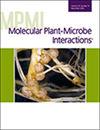Jana Sperschneider, Jian Chen, Claire Anderson, Emmanuelle Morin, Xiaoxiao Zhang, David Lewis, Eva Henningsen, Igor V Grigoriev, John P Rathjen, David A Jones, Sebastien Duplessis, Peter N Dodds
求助PDF
{"title":"亚麻锈菌的染色体基因组组装揭示了两个异常大的效应蛋白,AvrM3和AvrN。","authors":"Jana Sperschneider, Jian Chen, Claire Anderson, Emmanuelle Morin, Xiaoxiao Zhang, David Lewis, Eva Henningsen, Igor V Grigoriev, John P Rathjen, David A Jones, Sebastien Duplessis, Peter N Dodds","doi":"10.1094/MPMI-04-25-0047-R","DOIUrl":null,"url":null,"abstract":"<p><p>Rust fungi comprise thousands of species, many of which cause disease on important crop plants. The flax rust fungus <i>Melampsora lini</i> has been a model species for the genetic dissection of plant immunity since the 1940s; however, the highly fragmented and incomplete reference genome has so far hindered progress in effector gene discovery. Here, we generated a fully phased, chromosome-scale assembly of the two nuclear genomes of <i>M. lini</i> strain CH5, resolving an additional 320 Mbp of the sequence. The 482-Mbp dikaryotic genome is at least 79% repetitive, with a large proportion (approximately 40%) of the genome comprising young, highly similar transposable elements. The assembly resolves the known effector gene loci, some of which carry complex duplications that were collapsed in the previous assembly. Using a genetic map followed by manual correction of gene models, we identified the <i>AvrM3</i> and <i>AvrN</i> genes, which encode unusually large fungal effector proteins and trigger defense responses when co-expressed with the corresponding resistance genes. We located the genes linked to the tetrapolar mating system on chromosomes 4 and 9, but in contrast to the cereal rusts that have one pheromone receptor gene per haplotype, in flax rust, three pheromone receptor genes were found, with two of them closely linked on one haplotype. Taken together, we show that a high-quality assembly is crucial for resolving complex gene loci, and given the increasing number of fungal effectors of large size, the commonly applied criterion for effector candidates of being small proteins needs to be reconsidered. [Formula: see text] Copyright © 2025 The Author(s). This is an open access article distributed under the CC BY-NC-ND 4.0 International license.</p>","PeriodicalId":19009,"journal":{"name":"Molecular Plant-microbe Interactions","volume":" ","pages":"MPMI04250047R"},"PeriodicalIF":3.4000,"publicationDate":"2025-10-14","publicationTypes":"Journal Article","fieldsOfStudy":null,"isOpenAccess":false,"openAccessPdf":"","citationCount":"0","resultStr":"{\"title\":\"A Chromosome-Scale Genome Assembly of the Flax Rust Fungus Reveals the Two Unusually Large Effector Proteins, AvrM3 and AvrN.\",\"authors\":\"Jana Sperschneider, Jian Chen, Claire Anderson, Emmanuelle Morin, Xiaoxiao Zhang, David Lewis, Eva Henningsen, Igor V Grigoriev, John P Rathjen, David A Jones, Sebastien Duplessis, Peter N Dodds\",\"doi\":\"10.1094/MPMI-04-25-0047-R\",\"DOIUrl\":null,\"url\":null,\"abstract\":\"<p><p>Rust fungi comprise thousands of species, many of which cause disease on important crop plants. The flax rust fungus <i>Melampsora lini</i> has been a model species for the genetic dissection of plant immunity since the 1940s; however, the highly fragmented and incomplete reference genome has so far hindered progress in effector gene discovery. Here, we generated a fully phased, chromosome-scale assembly of the two nuclear genomes of <i>M. lini</i> strain CH5, resolving an additional 320 Mbp of the sequence. The 482-Mbp dikaryotic genome is at least 79% repetitive, with a large proportion (approximately 40%) of the genome comprising young, highly similar transposable elements. The assembly resolves the known effector gene loci, some of which carry complex duplications that were collapsed in the previous assembly. Using a genetic map followed by manual correction of gene models, we identified the <i>AvrM3</i> and <i>AvrN</i> genes, which encode unusually large fungal effector proteins and trigger defense responses when co-expressed with the corresponding resistance genes. We located the genes linked to the tetrapolar mating system on chromosomes 4 and 9, but in contrast to the cereal rusts that have one pheromone receptor gene per haplotype, in flax rust, three pheromone receptor genes were found, with two of them closely linked on one haplotype. Taken together, we show that a high-quality assembly is crucial for resolving complex gene loci, and given the increasing number of fungal effectors of large size, the commonly applied criterion for effector candidates of being small proteins needs to be reconsidered. [Formula: see text] Copyright © 2025 The Author(s). This is an open access article distributed under the CC BY-NC-ND 4.0 International license.</p>\",\"PeriodicalId\":19009,\"journal\":{\"name\":\"Molecular Plant-microbe Interactions\",\"volume\":\" \",\"pages\":\"MPMI04250047R\"},\"PeriodicalIF\":3.4000,\"publicationDate\":\"2025-10-14\",\"publicationTypes\":\"Journal Article\",\"fieldsOfStudy\":null,\"isOpenAccess\":false,\"openAccessPdf\":\"\",\"citationCount\":\"0\",\"resultStr\":null,\"platform\":\"Semanticscholar\",\"paperid\":null,\"PeriodicalName\":\"Molecular Plant-microbe Interactions\",\"FirstCategoryId\":\"99\",\"ListUrlMain\":\"https://doi.org/10.1094/MPMI-04-25-0047-R\",\"RegionNum\":3,\"RegionCategory\":\"生物学\",\"ArticlePicture\":[],\"TitleCN\":null,\"AbstractTextCN\":null,\"PMCID\":null,\"EPubDate\":\"\",\"PubModel\":\"\",\"JCR\":\"Q2\",\"JCRName\":\"BIOCHEMISTRY & MOLECULAR BIOLOGY\",\"Score\":null,\"Total\":0}","platform":"Semanticscholar","paperid":null,"PeriodicalName":"Molecular Plant-microbe Interactions","FirstCategoryId":"99","ListUrlMain":"https://doi.org/10.1094/MPMI-04-25-0047-R","RegionNum":3,"RegionCategory":"生物学","ArticlePicture":[],"TitleCN":null,"AbstractTextCN":null,"PMCID":null,"EPubDate":"","PubModel":"","JCR":"Q2","JCRName":"BIOCHEMISTRY & MOLECULAR BIOLOGY","Score":null,"Total":0}
引用次数: 0
引用
批量引用

 求助内容:
求助内容: 应助结果提醒方式:
应助结果提醒方式:


